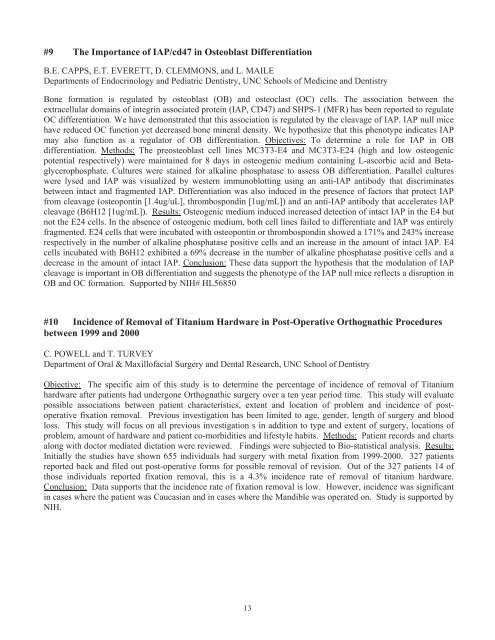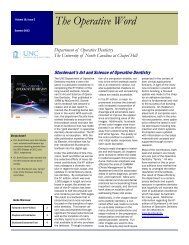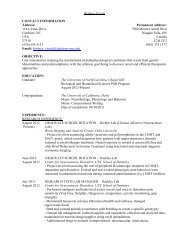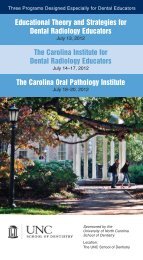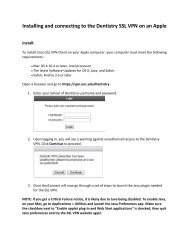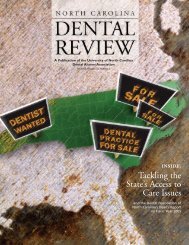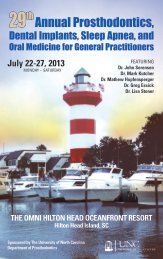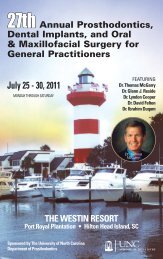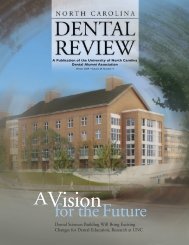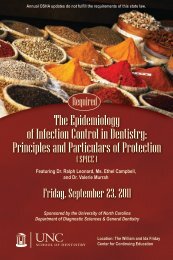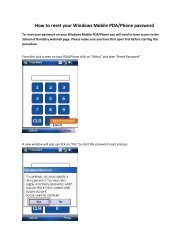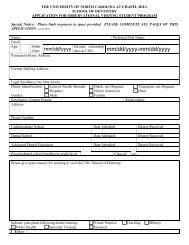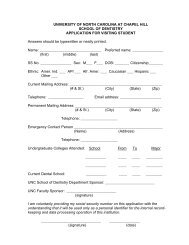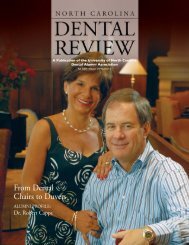UNC School of Dentistry - The University of North Carolina at ...
UNC School of Dentistry - The University of North Carolina at ...
UNC School of Dentistry - The University of North Carolina at ...
You also want an ePaper? Increase the reach of your titles
YUMPU automatically turns print PDFs into web optimized ePapers that Google loves.
#9 <strong>The</strong> Importance <strong>of</strong> IAP/cd47 in Osteoblast Differenti<strong>at</strong>ionB.E. CAPPS, E.T. EVERETT, D. CLEMMONS, and L. MAILEDepartments <strong>of</strong> Endocrinology and Pedi<strong>at</strong>ric <strong>Dentistry</strong>, <strong>UNC</strong> <strong>School</strong>s <strong>of</strong> Medicine and <strong>Dentistry</strong>Bone form<strong>at</strong>ion is regul<strong>at</strong>ed by osteoblast (OB) and osteoclast (OC) cells. <strong>The</strong> associ<strong>at</strong>ion between theextracellular domains <strong>of</strong> integrin associ<strong>at</strong>ed protein (IAP, CD47) and SHPS-1 (MFR) has been reported to regul<strong>at</strong>eOC differenti<strong>at</strong>ion. We have demonstr<strong>at</strong>ed th<strong>at</strong> this associ<strong>at</strong>ion is regul<strong>at</strong>ed by the cleavage <strong>of</strong> IAP. IAP null micehave reduced OC function yet decreased bone mineral density. We hypothesize th<strong>at</strong> this phenotype indic<strong>at</strong>es IAPmay also function as a regul<strong>at</strong>or <strong>of</strong> OB differenti<strong>at</strong>ion. Objectives: To determine a role for IAP in OBdifferenti<strong>at</strong>ion. Methods: <strong>The</strong> preosteoblast cell lines MC3T3-E4 and MC3T3-E24 (high and low osteogenicpotential respectively) were maintained for 8 days in osteogenic medium containing L-ascorbic acid and Betaglycerophosph<strong>at</strong>e.Cultures were stained for alkaline phosph<strong>at</strong>ase to assess OB differenti<strong>at</strong>ion. Parallel cultureswere lysed and IAP was visualized by western immunoblotting using an anti-IAP antibody th<strong>at</strong> discrimin<strong>at</strong>esbetween intact and fragmented IAP. Differenti<strong>at</strong>ion was also induced in the presence <strong>of</strong> factors th<strong>at</strong> protect IAPfrom cleavage (osteopontin [1.4ug/uL], thrombospondin [1ug/mL]) and an anti-IAP antibody th<strong>at</strong> acceler<strong>at</strong>es IAPcleavage (B6H12 [1ug/mL]). Results: Osteogenic medium induced increased detection <strong>of</strong> intact IAP in the E4 butnot the E24 cells. In the absence <strong>of</strong> osteogenic medium, both cell lines failed to differenti<strong>at</strong>e and IAP was entirelyfragmented. E24 cells th<strong>at</strong> were incub<strong>at</strong>ed with osteopontin or thrombospondin showed a 171% and 243% increaserespectively in the number <strong>of</strong> alkaline phosph<strong>at</strong>ase positive cells and an increase in the amount <strong>of</strong> intact IAP. E4cells incub<strong>at</strong>ed with B6H12 exhibited a 69% decrease in the number <strong>of</strong> alkaline phosph<strong>at</strong>ase positive cells and adecrease in the amount <strong>of</strong> intact IAP. Conclusion: <strong>The</strong>se d<strong>at</strong>a support the hypothesis th<strong>at</strong> the modul<strong>at</strong>ion <strong>of</strong> IAPcleavage is important in OB differenti<strong>at</strong>ion and suggests the phenotype <strong>of</strong> the IAP null mice reflects a disruption inOB and OC form<strong>at</strong>ion. Supported by NIH# HL56850#10 Incidence <strong>of</strong> Removal <strong>of</strong> Titanium Hardware in Post-Oper<strong>at</strong>ive Orthogn<strong>at</strong>hic Proceduresbetween 1999 and 2000C. POWELL and T. TURVEYDepartment <strong>of</strong> Oral & Maxill<strong>of</strong>acial Surgery and Dental Research, <strong>UNC</strong> <strong>School</strong> <strong>of</strong> <strong>Dentistry</strong>Objective: <strong>The</strong> specific aim <strong>of</strong> this study is to determine the percentage <strong>of</strong> incidence <strong>of</strong> removal <strong>of</strong> Titaniumhardware after p<strong>at</strong>ients had undergone Orthogn<strong>at</strong>hic surgery over a ten year period time. This study will evalu<strong>at</strong>epossible associ<strong>at</strong>ions between p<strong>at</strong>ient characteristics, extent and loc<strong>at</strong>ion <strong>of</strong> problem and incidence <strong>of</strong> postoper<strong>at</strong>ivefix<strong>at</strong>ion removal. Previous investig<strong>at</strong>ion has been limited to age, gender, length <strong>of</strong> surgery and bloodloss. This study will focus on all previous investig<strong>at</strong>ion s in addition to type and extent <strong>of</strong> surgery, loc<strong>at</strong>ions <strong>of</strong>problem, amount <strong>of</strong> hardware and p<strong>at</strong>ient co-morbidities and lifestyle habits. Methods: P<strong>at</strong>ient records and chartsalong with doctor medi<strong>at</strong>ed dict<strong>at</strong>ion were reviewed. Findings were subjected to Bio-st<strong>at</strong>istical analysis. Results:Initially the studies have shown 655 individuals had surgery with metal fix<strong>at</strong>ion from 1999-2000. 327 p<strong>at</strong>ientsreported back and filed out post-oper<strong>at</strong>ive forms for possible removal <strong>of</strong> revision. Out <strong>of</strong> the 327 p<strong>at</strong>ients 14 <strong>of</strong>those individuals reported fix<strong>at</strong>ion removal, this is a 4.3% incidence r<strong>at</strong>e <strong>of</strong> removal <strong>of</strong> titanium hardware.Conclusion: D<strong>at</strong>a supports th<strong>at</strong> the incidence r<strong>at</strong>e <strong>of</strong> fix<strong>at</strong>ion removal is low. However, incidence was significantin cases where the p<strong>at</strong>ient was Caucasian and in cases where the Mandible was oper<strong>at</strong>ed on. Study is supported byNIH.13


